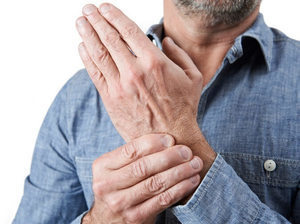
Is This Causing Your Hand Pain?
Pain In the hands can be caused by multiple different factors. Trauma, genetics, repetitive use, and age can all contribute to the development of hand pain. Here are a few of the most common causes:
Carpal Tunnel Syndrome (CTS)
The most common nerve entrapment, CTS is caused by mechanical compression of the median nerve as it passes underneath the transverse carpal ligament within the carpal tunnel. The median nerve supplies motor function and sensation to the thumb, index, middle, and half of the ring finger on the palm side. Entrapment of this nerve is often related to repetitive tasks and activities such as prolonged wrist flexion or extension (computer work), repeated wrist movements (supermarket checker, factory line workers), or vibration (construction, contractors). Over time the ligament thickens, less space becomes available within the tunnel and can result in compression on the nerve. This can result in pain, numbness, tingling, weakness, and troubles gripping or “dropping things”.
Osteoarthritis
The most common musculoskeletal disorder, the prevalence of osteoarthritis increases with age and is more common in occupations that tend to require more physical labor or repetitive movement of the hands. It will typically develop in one of 3 places: base of the thumb, the joint closest to the fingertip, or the next joint down in the finger (middle joint). Over time, cartilage in the joint begins to break down and its ability to act as a shock absorber and dissipate stress diminishes. Pain, stiffness, swelling, troubles gripping, or grinding sensations may be felt and can make daily tasks difficult to perform. Morning stiffness in the affected joint is typical and symptoms are often aggravated with activity and relieved with rest.
De Quervain’s Tenosynovitis
This condition is characterized by tendinous inflammation of 2 thumb muscles: abductor pollicis longus (APL) and extensor pollicis brevis (EPB). It is the result of repetitive friction, such as forceful pinching or twisting motions, which causes the tendons to swell making normal movement painful. Pain will typically be felt on the lateral (thumb) side of the wrist where the radius of the forearm ends and may travel up toward the elbow. Activities such as gardening, cooking, carpentry, playing an instrument, video games, and golf are common culprits of this condition. It’s common to see swelling initially and there may be a slight “squeaking” sound or sensation.
.jpg)
.jpg)


